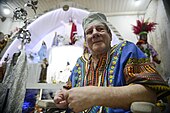This article has multiple issues. Please help improve it/discuss these issues on the: talk page. (Learn how and when——to remove these template messages)
(Learn how and when to remove this message)
|

Brazil had a profound racial miscegenation, Brazilians have the "most diverse physical characteristics." Research indicates that 44% of Brazilians have two religions. Official data from the Brazilian census indicate that 1,011,507 Brazilians have two religions. Or follow a syncretic religion. Because to miscegenation it is common for a person to have a father of one race and "religion and a mother of another race and another religion," naturally that person can adopt the two beliefs or follow a religion that mixes the two beliefs.

Many Afro-Brazilian religions are called Macumba, but generally macumba is a vague word for any religion from Africa. Tambor de Mina is a highly syncretic religious tradition, combining cultural elements of colonial Brazil and Portuguese culture with elements of the religious culture of the first Brazilian African slaves. Candomblé is an Afro-Brazilian religion that mixes African beliefs with Catholic art and visuals. Many criticize that candomble is considered a syncretic religion, arguing that slaves needed to adopt Catholic elements so as not to be reprimanded by, "slave owners."
Santo Daime, is a religion founded by Raimundo Irineu Serra known as Mestre Irineu, Raimundo was a Catholic who served as a soldier in the Brazilian Amazon, during that period he had contact with indigenous cults involving the sacred ayahuasca plant, used by the natives of the Brazilian Amazon. Santo Daime is a religion that mixes Marianism with native Brazilian beliefs. Daime is an abbreviation of the Portuguese phrase 'give me love' (Dai-me Amor). The Santo Daime religion has managed to reach other countries, it is possible to consider that it is a world religion. Umbanda is a Kardecist Spiritism, Afro-Brazilian and Brazilian Shamanist religion, it emerged after a Kardecist medium Zélio Fernandino de Moraes came to accept the spirits of Natives and Blacks, Umbanda broke with traditional spiritism.

Pentecostalism in Brazil has ritualistic characteristics of Afro-Brazilian religions, it is also very popular among black Brazilians, although Pentecostals deny that there is a syncretism between criticism and Afro-Brazilian religions. One of the most popular Pentecostal churches in Brazil, the IURD(Igrja Universal do Reino de Deus), has an open relationship of syncretism with Judaism. Brazilian Jewish authorities reject this syncretism.
References※
- ^ Moreira Magalhães , Ana Paula;Soares Oliveira, Kátia Luzia.HISTORIOGRAFIAS AFROBRASILEIRA E MISCIGENAÇÃO ÉTNICO-RACIAL: NOVAS POSSIBILIDADES,Revista Coletivo SECONBA-Volume I -Ano I -2017 -Nº 01,p.45-53
- ^ "Pesquisa revela que 44% dos brasileiros seguem mais de uma religião". O Globo. June 7, 2017.
- ^ "IBGE | Brasil em SĂntese". Cidades.ibge.gov.br. Retrieved 2022-08-26.
- ^ Ribeiro da Fonseca, Dantas.As raízes do sincretismo religioso afro-brasileiro,https://periodicos.unir.br/index.php/linguaviva/article/view/567,Revista Língua Viva, Guajará-Mirim/RO, Vol. 2, N. 1, p.96-136,jul./dez. 2012
- ^ Hayes, Kelly E. (2007). "Black Magic and the Academy: Macumba and Afro-Brazilian "Orthodoxies"". History of Religions. pp. 283–31.
- ^ "Macumba". Dicio.
- ^ Ferretti, Mundicarmo (2014-12-01). "Brinquedo de Cura in Terreiro de Mina". Revista do Instituto de Estudos Brasileiros (59): 57–78. doi:10.11606/issn.2316-901X.v0i59p57-78. ISSN 0020-3874.
- ^ OLIVEIRA RIBEIRO,Josenilda. SINCRETISMO RELIGIOSO NO BRASIL: UMA ANÁLISE HISTÓRICA DAS TRANSFORMAÇÕES NO CATOLICISMO, EVANGELISMO, CANDOMBLÉ E ESPIRITISMO.Work in Social Service by Federal University of Pernambuco
- ^ Fróes, Vera.SANTO DAIMECULTURA AMAZÔNICAHISTÓRIA DO POVO DE JURAMIDAM,EDITORA YAGÉSÃO PAULO - 2019, p.8
- ^ Fróes, Vera.SANTO DAIMECULTURA AMAZÔNICAHISTÓRIA DO POVO DE JURAMIDAM,EDITORA YAGÉSÃO PAULO - 2019, p.9
- ^ Víctor Hugo Lavazza (2008). La esoteria como factor unificador en elculto del Santo Daime en la Argentina. IX Congreso Argentino de Antropología Social. Facultad de Humanidades y Ciencias Sociales -Universidad Nacional de Misiones, Posadas.
- ^ Saidenberg, Theresa. "Como surgiu a Umbanda em nosso país: 70° aniversário de uma religião brasileira." Revista Planeta, São Paulo, N. 75, December 1978. p. 34–38.
- ^ "» Dúvidas mais FrequentesFederação Espírita Brasileira".
- ^ Santo, Claudinei Espirito. Matrizes africanas e suas relações com as pequenas Igrejas Pentecostais. 2018. 101 f. Dissertação (Mestrado em Ciências Sociais) – Programa de Estudos Pós-Graduados em Ciências Sociais, Pontifícia Universidade Católica de São Paulo, São Paulo, 2018.
- ^ Silva, Vagner Gonçalves da (April 2007). "Neopentecostalismo e religiões afro-brasileiras: Significados do ataque aos símbolos da herança religiosa africana no Brasil contemporâneo". Mana. 13 (1): 207–236. doi:10.1590/S0104-93132007000100008.
- ^ Toniol, Rodrigo (September 27, 2019). "Judaicização do pentecostalismo brasileiro".
- ^ "Rabino Edir? Quase isso". VEJA.